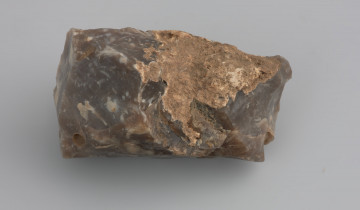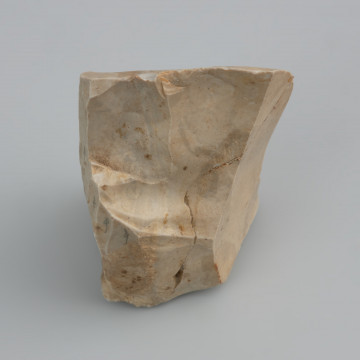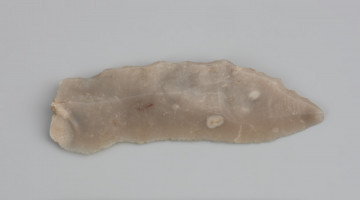
Two-stacked prismatic core
9600 p.n.e. — 9000 p.n.e.
National Museum in Szczecin
Part of the collection: Stone Age
A single-platform blade core was found in Lubieszewo, the Gryfice district, in 1967 during archaeological research of a settlement complex from the Roman influence period. Technologically and morphologically, it refers to the flint tradition of the late Palaeolithic people representing the Hamburg culture. The core was worked with a soft pestle, although it is difficult to determine whether this was organic (bone, antler) or mineral (soft rock such as sandstone). As the volume diminished, the core was refreshed - the heel, or plane, which was struck to retrieve the half-raw material, was formed with numerous fresh break-offs, known as freshets. One of the last operations before being abandoned altogether was the preparation of a point to bounce the chip off the narrow front plane. The core was abandoned, most likely due to a crack that destroyed part of the splint. The maker attempted to repair it, but it led to an even more resounding crack. The core maker probably had quite a lot of knowledge but at most average skills. The is evidenced by the features such as an unkept edge, the reorientation of the core several times, the poor execution of strikes resulting in the fracture of several chips and the failure to repair the afore-mentioned crack.
Michał Adamczyk
Author / creator
Dimensions
cały obiekt: height: 6.8 cm, width: 4.6 cm
Object type
lithic core, production waste
Technique
carving, soft masher carving, hard masher carving
Material
flint, stone
Origin / acquisition method
field research
Creation time / dating
Creation / finding place
Owner
National Museum in Szczecin
Identification number
Location / status

9600 p.n.e. — 9000 p.n.e.
National Museum in Szczecin

12700 p.n.e. — 11900 p.n.e.
National Museum in Szczecin

11900 p.n.e. — 11000 p.n.e.
National Museum in Szczecin
DISCOVER this TOPIC
National Museum in Lublin
DISCOVER this PATH
Educational path